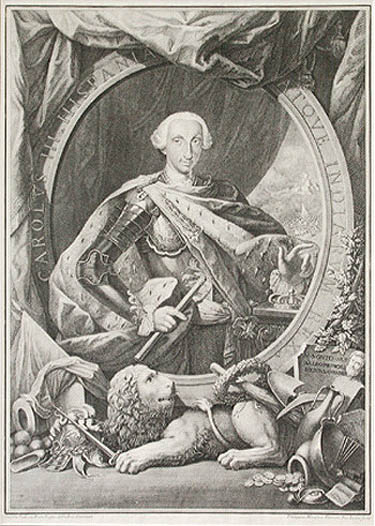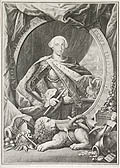| Title: |
Carlos III Hispania Atque Indiarum Rex (Charles III, King of Spain) |
| Engraver: |
Morghen, Filippo (Florence, 1730 - Naples, 1777) |
| Designer: |
Paderni, Camillus (Naples, c. 1720 - 1770) |
| Date: |
c. 1760 |
| Medium: |
Original Engraving |
| Note: |
Filippo Morghen was an accomplished eighteenth
century engraver of portraits, architectural views, antiquities, plans
and maps. He studied art in Rome for a period of seven years before settling
in Naples were he not only created etchings and engravings but established
himself as a print seller and as a publisher. Filippo Morghen was a leading engraver
for the recent archaeological discoveries detailed in the Antiquities
of Herculaneum, published in Naples in 1757, and the sole engraver
and publisher of Views of Ruins in the Environs of Naples, published
in 1766. In fact, reference is made to the discoveries at Herculaneum
(then a Spanish possession) in the lower right corner of this portrait engraving of Charles III, King of Spain,
where we see ancient pottery and sculpture as well as archeological tools-of-the-trade,
such as a shovel and a pick. |
| |
Filippo Morghen's fine engravings earned him the title
of 'Engraver to the King of the Two Sicilies'. He was also the father
and teacher of
Rafaello Morghen (1758-1833), one of the most influential engravers of
the late eighteenth and early nineteenth centuries. Carlos III Hispania
Atque Indiarum Rex is based upon a design created by the eighteenth century
Italian artist, Camillus Paderni (Naples, c. 1720 - 1770). |
| Note: |
A Biographical Note: Carlos III ascended to the Spanish
throne in 1759. The forty-three year old monarch had already reigned
for twenty five years in Naples and was to remain on the Spanish throne
for almost thirty more years (1759 - 1788). His reign in both Spain and
Naples was marked by honesty and integrity: qualities difficult to find
on any throne during this time. In Spain, Carlos improved the lot of
the poor, rebuilt roads and fought hard won battles against criminals.
On his death, he was succeeded by his son, Carlos IV; one of the weakest
and the most ineffectual kings in Spanish history. |
| |
In relation to the arts, Carlos III was responsible for
bringing outstanding Italian painters to his court at Madrid, such as
Mengs and Tiepolo. He also established high standards for Spanish art
and in his court one rose to become Spain’s greatest: Francisco Goya. |
| Raisonne: |
G. K. Nagler, Neues allgemeines Kunstler-Lexicon,
Schwarzenberg & Schumann, Leipzig (3rd. edition), Volume 11, pp. 1 & 2. |
| |
Nagler speculates that this large portrait of Carlos III
was executed between 1759 and 1763. |
| Size: |
17 3/4 X 12 3/8 (Sizes in inches are approximate,
height preceding width of plate-mark or image.) |
| |
Matted with 100% Archival Materials |
| Condition: |
Printed on mid eighteenth century hand-made, laid paper
and with margins cropped at the plate-mark, as was customary. It is a
fine, early impression in excellent condition throughout and an outstanding
example of the 18th century portrait engraving. This original engraving stands as a prime example
of the famous art of Filippo Morghen. |
| Price: |
Sold - The price is no longer available. |
| Important Information: |
The artist biographies, research and or information pertaining to all the original works of art posted on our pages has been written and designed by Greg & Connie Peters exclusively for our site, (www.artoftheprint.com). Please visit us regularly to view the latest artworks offered for sale. We will soon be posting an update of our most recent research and include the biographical and historical information pertaining to our next collection of original works of art created by artists throughout the centuries. We hope you found the information you were looking for and that it has been beneficial.
Our Gallery, (Art of the Print / www.artoftheprint.com) guarantees the authenticity of every work of art we sell 100%. Full documentation and certification is provided. We offer a wide selection of international fine art dating from the early Renaissance to the contemporary art period. |








![]()
![]() or
phone Greg & Connie (905) 957-6666
or
phone Greg & Connie (905) 957-6666